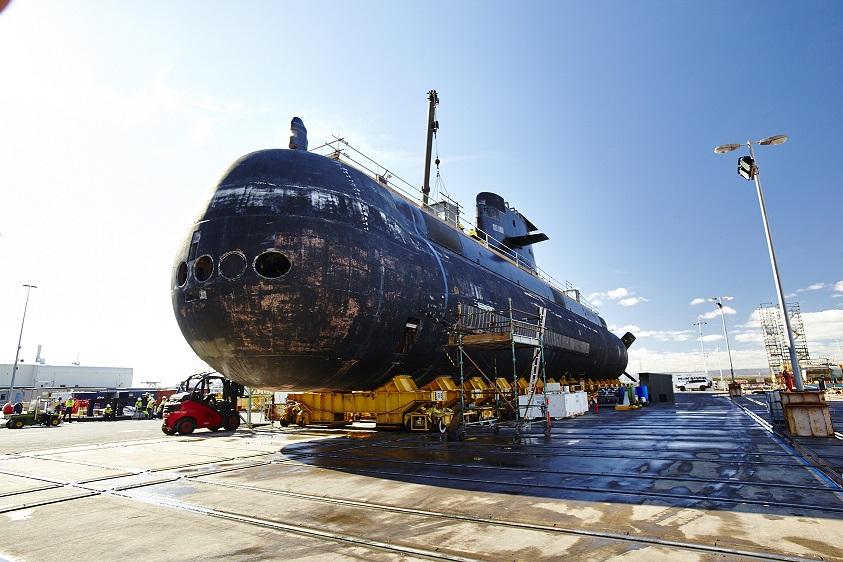 As members of the Defence Minister’s White Paper Expert Panel, Mike Kalms and I have been asked to help prepare the next Defence Industry Policy Statement (DIPS). An important part of that process has been getting around the country talking to defence industry stakeholders to capture their views. The results of our work will have to wait until government has decided which policy settings it wants to pursue before they’ll see the light of day, but getting out of the office and onto worksites gives a fresh perspective not always available from reading reports. And it gives me a chance to wear a fluoro vest and hard hat.
As members of the Defence Minister’s White Paper Expert Panel, Mike Kalms and I have been asked to help prepare the next Defence Industry Policy Statement (DIPS). An important part of that process has been getting around the country talking to defence industry stakeholders to capture their views. The results of our work will have to wait until government has decided which policy settings it wants to pursue before they’ll see the light of day, but getting out of the office and onto worksites gives a fresh perspective not always available from reading reports. And it gives me a chance to wear a fluoro vest and hard hat.
I thought I’d share some observations I made on a recent trip to the submarine side of ASC. (My impressions from a previous visit to the shipbuilding side of the business are here.) Like all the industry players and associations we’ve approached, ASC were good about making time for a discussion and briefing. It’s natural that industry wants to get their views across, but in this case there was another reason for them to be keen to engage: they have some good news to report. I’ve been a regular visitor to ASC submarines for some years now, but this was my first trip since the Coles Review recommendations really got to the implementation stage.
So, what did I find? The most obvious thing was that the submarine-maintenance facility now looks like the hive of industry you’d expect to see in support of a major national defence capability. That might sound superficial, but it’s a striking difference. Where there was once a submarine ‘on blocks’ in the shed with a few small groups of workers gathered at one or two points because there wasn’t much room to work efficiently, there’s now a significant piece of infrastructure inside the shed that allows access to the submarine at multiple points at various levels. And work can now be disaggregated and proceed in parallel, with heavy machinery lifted out of the hull for work ‘alongside’ while the now-empty spaces inside the hull allow much better access to the internals of the boat.
But as important—if not as obvious to the naked eye—is a major reorganisation of the management arrangements between the various players in the submarine enterprise: Navy as capability manager and end customer, DMO as acquisition authority, ASC as maintainer and the Department of Finance as owner. There was previously a confusing and inefficient overlap of responsibilities between the various entities. It resulted in silliness, like maintenance work being held up because the maintainers had to wait for parts—often from offsite—because the procurement and warehousing side of the operation weren’t on the same page.
Diffuse responsibility also meant that no one was able to be held accountable when things inevitably went wrong. The national submarine enterprise consisted of a group of enmeshed and non-moving parts. That’s why essentially all (nine and a half out of ten) of the key recommendations in the Coles Review related to management arrangements. The reputation of the submarines themselves was collateral damage in what was a failure to properly manage the submarine fleet. The public perception of the Collins remains resolutely one of ‘dud subs‘. In truth, after the initial (and not insubstantial) technical problems were ironed out, for a long time they were good subs under dud collective management.
Today the division of labour and responsibility is much clearer and decision making is being devolved appropriately. The impact of those changes has been dramatic. There’s been a nearly 40% reduction in man-hours required for a full-cycle docking (the two-year-long overhaul and refurbishment process at the end of major duty cycles). That’s a productivity gain that the yard is proud of, and the morale of the workforce seems markedly higher as a result.
The result of those efforts has been a marked improvement in the availability of Collins boats for operations and training—which is ultimately what it has to be about. We don’t have long-term metrics yet and so it’s a little early to hail a renaissance in Australia’s submarine capability, but it’s fair to say that Collins submarine-availability report cards have gone from ‘must do better’ to ‘progressing well’.
It’s a crying shame that a $10 billion national investment in submarines had to fall over before the collective heads were conked together and told to sort it out. No doubt there are further improvements to be made, but so far the results are looking pretty good.
Andrew Davies is senior analyst for defence capability and director of research at ASPI. Image courtesy of ASC Pty Ltd.